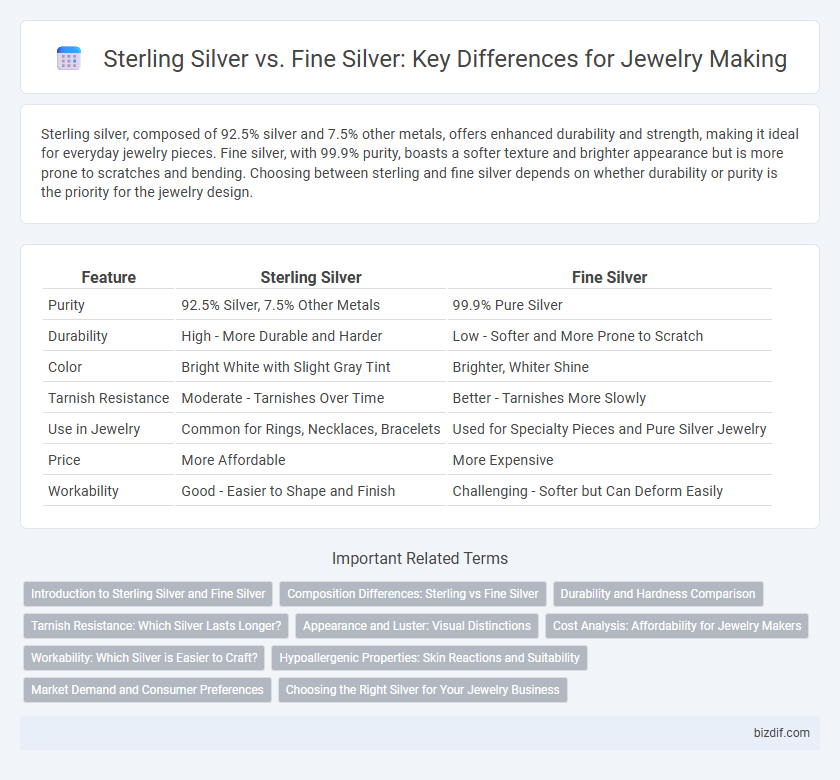Sterling silver, composed of 92.5% silver and 7.5% other metals, offers enhanced durability and strength, making it ideal for everyday jewelry pieces. Fine silver, with 99.9% purity, boasts a softer texture and brighter appearance but is more prone to scratches and bending. Choosing between sterling and fine silver depends on whether durability or purity is the priority for the jewelry design.
Table of Comparison
| Feature | Sterling Silver | Fine Silver |
|---|---|---|
| Purity | 92.5% Silver, 7.5% Other Metals | 99.9% Pure Silver |
| Durability | High - More Durable and Harder | Low - Softer and More Prone to Scratch |
| Color | Bright White with Slight Gray Tint | Brighter, Whiter Shine |
| Tarnish Resistance | Moderate - Tarnishes Over Time | Better - Tarnishes More Slowly |
| Use in Jewelry | Common for Rings, Necklaces, Bracelets | Used for Specialty Pieces and Pure Silver Jewelry |
| Price | More Affordable | More Expensive |
| Workability | Good - Easier to Shape and Finish | Challenging - Softer but Can Deform Easily |
Introduction to Sterling Silver and Fine Silver
Sterling silver consists of 92.5% pure silver alloyed with 7.5% copper or other metals, enhancing its strength and durability for jewelry making. Fine silver is 99.9% pure silver, prized for its bright luster and hypoallergenic properties but is softer and more prone to scratching. Both metals offer unique benefits, with sterling silver favored for everyday wear and fine silver preferred for delicate, high-end pieces.
Composition Differences: Sterling vs Fine Silver
Sterling silver consists of 92.5% pure silver alloyed with 7.5% other metals, typically copper, enhancing its durability and hardness for jewelry making. Fine silver contains 99.9% pure silver, offering a softer and more malleable material but less resistance to scratching and deformation. These composition differences directly impact the metal's suitability for various jewelry designs and wearability.
Durability and Hardness Comparison
Sterling silver, composed of 92.5% pure silver and 7.5% other metals like copper, offers superior durability and hardness compared to fine silver, which is 99.9% pure silver. The added alloy in sterling silver enhances its resistance to scratching and bending, making it ideal for everyday jewelry wear. Fine silver, though softer and more malleable, is prone to dents and deformation, requiring careful handling to maintain its pristine appearance.
Tarnish Resistance: Which Silver Lasts Longer?
Sterling silver, composed of 92.5% silver and 7.5% other metals like copper, exhibits greater durability and moderate tarnish resistance compared to fine silver, which is 99.9% pure but softer and more prone to oxidation. Fine silver tarnishes more slowly due to its high purity but scratches easily, while sterling silver forms a protective oxide layer that may darken over time but can be polished to restore shine. For jewelry makers prioritizing longevity and maintenance, sterling silver offers a balanced choice between durability and tarnish resistance.
Appearance and Luster: Visual Distinctions
Sterling silver features a bright, shiny white appearance with a polished finish, reflecting light vividly due to its copper alloy content, which also adds slight warmth to its luster. Fine silver, composed of 99.9% pure silver, presents a softer, more muted sheen with a subtle grayish tone, lacking the intense brilliance of sterling silver. Jewelry makers prefer sterling silver for pieces requiring high reflectivity and durability, while fine silver is chosen for its richer, more matte visual quality.
Cost Analysis: Affordability for Jewelry Makers
Sterling silver, composed of 92.5% silver and 7.5% other metals, offers a more affordable option for jewelry makers compared to fine silver, which is 99.9% pure silver but significantly softer and pricier. The added alloy in sterling silver not only enhances durability but reduces material costs, making it suitable for intricate designs and high-volume production. Fine silver's higher cost limits its use to specialty items or pieces requiring superior tarnish resistance despite increased expense.
Workability: Which Silver is Easier to Craft?
Sterling silver, composed of 92.5% silver alloyed with copper, offers greater hardness and durability, making it ideal for intricate jewelry designs requiring structural strength. Fine silver, being 99.9% pure, is softer and more malleable, allowing easier shaping and detailing but is prone to scratching and deformation. Jewelers often prefer sterling silver for pieces needing resilience, while fine silver is favored for delicate work and repousse techniques due to its superior workability.
Hypoallergenic Properties: Skin Reactions and Suitability
Sterling silver, composed of 92.5% pure silver alloyed with 7.5% other metals like copper, may cause skin reactions in individuals sensitive to alloys, whereas fine silver is 99.9% pure and generally hypoallergenic, reducing the risk of irritation. Jewelry makers often prefer fine silver for pieces intended for sensitive skin due to its minimal alloy content, though it is softer and less durable than sterling silver. Understanding the hypoallergenic properties of these metals helps in selecting suitable materials for clients prone to allergies or skin sensitivities.
Market Demand and Consumer Preferences
Sterling silver, an alloy containing 92.5% silver and 7.5% other metals, dominates market demand due to its durability and affordability, appealing to consumers seeking long-lasting jewelry. Fine silver, consisting of 99.9% pure silver, attracts niche markets focused on purity and investment value but is less favored for everyday wear due to its softness. Consumer preferences lean toward sterling silver for its balance of quality, price, and versatility in fashion jewelry.
Choosing the Right Silver for Your Jewelry Business
Sterling silver, composed of 92.5% pure silver and 7.5% other metals, offers enhanced durability and strength ideal for jewelry pieces that require long-lasting wear. Fine silver, which is 99.9% pure, provides a softer, more malleable option best suited for intricate designs but may be prone to scratches and bends. Selecting the right silver depends on balancing the need for durability with design complexity to meet customer preferences and ensure product longevity.
Sterling silver vs fine silver Infographic

 bizdif.com
bizdif.com